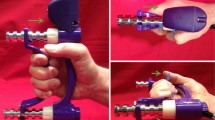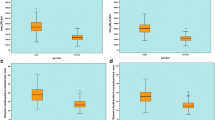Abstract
Introduction
Grip strength and load distribution of the hand are important parameters for evaluating hand function. The purpose of this study was to analyze and compare grip force and load distribution of dominant and nondominant hands in right-handed healthy subjects.
Methods
Gripping measurements were performed on 40 healthy right-handed subjects using a cylindrical gripping device. Two different cylinders with circumferences of 150 mm (small cylinder) and 200 mm (large cylinder), respectively, were used for the measurements. Subjects were assigned to either the small or the large cylinder with respect to their hand size. Maximum and mean force applied during three intervals of gripping as well as the percent contribution of each digit, thenar, and hypothenar in relation to the total load applied were acquired. Values of dominant and nondominant hands were compared.
Results
Percent contribution of mean grip strength differed for the thumb (p = 0.007), ring finger (p < 0.001), little finger (p = 0.047), and palm (p < 0.001). Comparing the dominant and nondominant side, the dominant hand showed a lower contribution of the thumb, ring finger, and little finger, but a higher contribution of the palm. When analyzing maximum grip, percent contribution of the small fingers was equal between dominant and nondominant side (p = 0.1). Differences between dominant and nondominant thumb, ring finger, and palm persisted (p = 0.007, p = 0.001, p = 0.005, respectively). No differences could be shown for the index finger, middle finger, thenar, and hypothenar when analyzing both mean and maximum force.
Discussion and conclusion
Percent contribution of the thumb and the fingers to total grip strength differed between dominant and nondominant hands with a change in distribution when assessing maximum grip force. In right-handed subjects, thumb and ring finger have important roles during gripping.





Similar content being viewed by others
References
Kim JK, Park MG, Shin SJ (2014) What is the minimum clinically important difference in grip strength? Clin Orthop Relat Res 472(8):2536–2541. https://doi.org/10.1007/s11999-014-3666-y
Wachter NJ, Mentzel M, Krischak GD, Gulke J (2017) Quantification of hand function by power grip and pinch strength force measurements in ulnar nerve lesion simulated by ulnar nerve block. J Hand Ther. https://doi.org/10.1016/j.jht.2017.05.016
Radhakrishnan S, Nagaravindra M (1993) Analysis of hand forces in health and disease during maximum isometric grasping of cylinders. Med Biol Eng Comput 31(4):372–376
Talsania JS, Kozin SH (1998) Normal digital contribution to grip strength assessed by a computerized digital dynamometer. J Hand Surg Br 23(2):162–166
Wachter NJ, Mentzel M, Hutz R, Gulke J (2017) Reliability of the grip strength coefficient of variation for detecting sincerity in normal and blocked median nerve in healthy adults. Hand Surg Rehabil 36(2):90–96. https://doi.org/10.1016/j.hansur.2016.12.003
Chen PT, Jou IM, Lin CJ, Chieh HF, Kuo LC, Su FC (2015) Is the control of applied digital forces during natural five-digit grasping affected by carpal tunnel syndrome? Clin Orthop Relat Res 473(7):2371–2382. https://doi.org/10.1007/s11999-015-4189-x
Zhang W, Johnston JA, Ross MA, Sanniec K, Gleason EA, Dueck AC, Santello M (2013) Effects of carpal tunnel syndrome on dexterous manipulation are grip type-dependent. PLoS One 8(1):e53751. https://doi.org/10.1371/journal.pone.0053751
Kozin SH, Porter S, Clark P, Thoder JJ (1999) The contribution of the intrinsic muscles to grip and pinch strength. J Hand Surg Am 24(1):64–72. https://doi.org/10.1053/jhsu.1999.jhsu24a0064
Kwon GD, Ahn BM, Lee JS, Park YG, Ha YC (2016) Clinical outcomes of a simultaneous replantation technique for amputations of four or five digits. Microsurgery 36(3):225–229. https://doi.org/10.1002/micr.30009
Chow SP, Ng C (1993) Hand function after digital amputation. J Hand Surg Br 18(1):125–128
Rijnja JP, Kouwenberg P, Ray S, Walbeehm ET (2017) Robert Mathys Finger prosthesis of the proximal interphalangeal joint: a retrospective case series of 19 joints in 17 patients. Arch Orthop Trauma Surg 137(8):1155–1160. https://doi.org/10.1007/s00402-017-2725-8
Spies CK, Langer M, Hahn P, Müller LP, Unglaub F (2018) The treatment of primary arthritis of the finger and thumb joint. Deutsches Aerzteblatt Online
American Medical Association (1993) Guides to the evaluation of permanent impairment, 4th edn. American Medical Association, Chicago
Nicholas JW, Corvese RJ, Woolley C, Armstrong TJ (2012) Quantification of hand grasp force using a pressure mapping system. Work 41 Suppl 1:605–612. https://doi.org/10.3233/WOR-2012-0217-605
Gulke J, Wachter NJ, Katzmaier P, Ebinger T, Mentzel M (2007) Detecting submaximal effort in power grip by observation of the strength distribution pattern. J Hand Surg Eur 32(6):677–683. https://doi.org/10.1016/J.JHSE.2007.05.020
Dustmann M, Bajinski R, Tripp A, Gulke J, Wachter N (2017) A modified Matti-Russe technique of grafting scaphoid non-unions. Arch Orthop Trauma Surg 137(6):867–873. https://doi.org/10.1007/s00402-017-2680-4
Hernekamp JF, Kneser U, Kremer T, Bickert B (2017) [Midcarpal partial arthrodesis with locking plate osteosynthesis]. Oper Orthop Traumatol. https://doi.org/10.1007/s00064-017-0514-8
Kohler S, Koch K, Arsalan-Werner A, Mehling IM, Seegmuller J, Krimmer H, Sauerbier M (2017) [Wrist arthrodesis with a fixed-angle, “low-profile” fusion plate without carpometacarpal joint fixation]. Oper Orthop Traumatol. https://doi.org/10.1007/s00064-017-0517-5
Muhldorfer-Fodor M, Ziegler S, Harms C, Neumann J, Cristalli A, Kalpen A, Kundt G, Mittlmeier T, Prommersberger KJ (2014) Grip force monitoring on the hand: manugraphy system versus Jamar dynamometer. Arch Orthop Trauma Surg 134(8):1179–1188. https://doi.org/10.1007/s00402-014-2027-3
Amis AA (1987) Variation of finger forces in maximal isometric grasp tests on a range of cylinder diameters. J Biomed Eng 9(4):313–320
Lee JW, Rim K (1991) Measurement of finger joint angles and maximum finger forces during cylinder grip activity. J Biomed Eng 13(2):152–162
Petersen P, Petrick M, Connor H, Conklin D (1989) Grip strength and hand dominance: challenging the 10% rule. Am J Occup Ther 43(7):444–447
Muhldorfer-Fodor M, Ziegler S, Harms C, Neumann J, Kundt G, Mittlmeier T, Prommersberger KJ (2017) Load distribution of the hand during cylinder grip analyzed by manugraphy. J Hand Ther 30(4):529–537. https://doi.org/10.1016/j.jht.2016.10.009
Rossi JGdM B, Berton E, Vigouroux L (2015) Handle shape affects the grip force distribution and the muscle loadings during power grip tasks. J Appl Biomech 31:430–438
Mentzel M, Apic G, Wachter NJ, Bauknecht S, Gulkin D, Gulke J (2011) [Assessment of force patterns of different primary grips through dynamic force measurement using a sensor glove]. Handchir Mikrochir Plast Chir 43(3):155–161. https://doi.org/10.1055/s-0031-1271805
Shechtman O, Mann WC, Justiss MD, Tomita M (2004) Grip strength in the frail elderly. Am J Phys Med Rehabil 83(11):819–826
Fraser LE, Harris LR (2017) The effect of hand position on perceived finger orientation in left- and right-handers. Exp Brain Res 235(12):3683–3693. https://doi.org/10.1007/s00221-017-5090-5
Gunther CM, Burger A, Rickert M, Crispin A, Schulz CU (2008) Grip strength in healthy caucasian adults: reference values. J Hand Surg Am 33(4):558–565. https://doi.org/10.1016/j.jhsa.2008.01.008
Lee JA, Sechachalam S (2016) The effect of wrist position on grip endurance and grip strength. J Hand Surg Am 41(10):e367–e373. https://doi.org/10.1016/j.jhsa.2016.07.100
Ozcan A, Tulum Z, Pinar L, Baskurt F (2004) Comparison of pressure pain threshold, grip strength,dexterity and touch pressure of dominant and non-dominant hands within and between right-and left-handed subjects. J Korean Med Sci 19(6):874–878. https://doi.org/10.3346/jkms.2004.19.6.874
Muhldorfer-Fodor M, Reger A, Schoonhoven J, Mittlmeier T, Prommersberger KJ (2015) The effect of midcarpal versus total wrist fusion on the hand’s load distribution during gripping. J Hand Surg Am 40(11):2183–2190. https://doi.org/10.1016/j.jhsa.2015.08.010
Wichelhaus A, Harms C, Neumann J, Ziegler S, Kundt G, Prommersberger KJ, Mittlmeier T, Muhldorfer-Fodor M (2018) Parameters influencing hand grip strength measured with the manugraphy system. BMC Musculoskelet Disord 19(1):54. https://doi.org/10.1186/s12891-018-1971-4
Funding
There is no funding source.
Author information
Authors and Affiliations
Corresponding author
Ethics declarations
Conflict of interest
The authors declare that they have no potential conflict of interest.
Rights and permissions
About this article
Cite this article
Cai, A., Pingel, I., Lorz, D. et al. Force distribution of a cylindrical grip differs between dominant and nondominant hand in healthy subjects. Arch Orthop Trauma Surg 138, 1323–1331 (2018). https://doi.org/10.1007/s00402-018-2997-7
Received:
Published:
Issue Date:
DOI: https://doi.org/10.1007/s00402-018-2997-7




